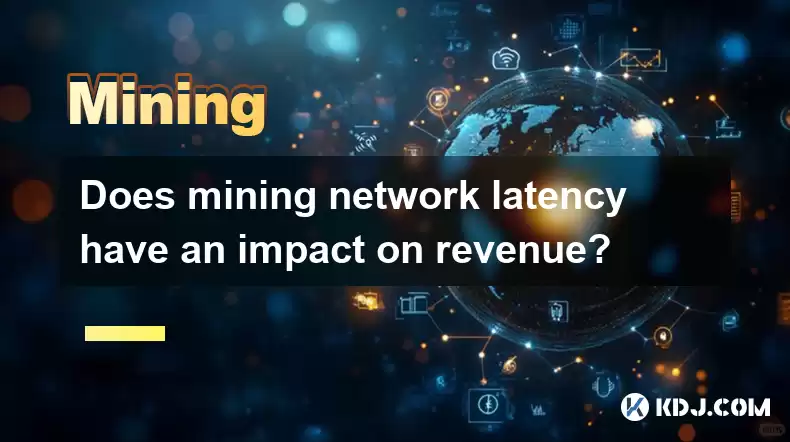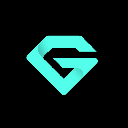-
 bitcoin
bitcoin $122288.232522 USD
0.16% -
 ethereum
ethereum $4480.662914 USD
-0.22% -
 xrp
xrp $2.962747 USD
-2.32% -
 tether
tether $1.000120 USD
-0.05% -
 bnb
bnb $1145.654223 USD
-2.07% -
 solana
solana $227.105217 USD
-1.67% -
 usd-coin
usd-coin $0.999548 USD
-0.02% -
 dogecoin
dogecoin $0.250875 USD
-2.04% -
 tron
tron $0.340654 USD
-0.49% -
 cardano
cardano $0.837968 USD
-2.52% -
 hyperliquid
hyperliquid $48.960449 USD
0.06% -
 chainlink
chainlink $22.049280 USD
-1.33% -
 ethena-usde
ethena-usde $1.000404 USD
0.02% -
 sui
sui $3.586212 USD
0.20% -
 avalanche
avalanche $29.894916 USD
-4.18%
Does mining network latency have an impact on revenue?
High network latency reduces mining profitability by increasing orphaned blocks, impacting revenue depending on hash rate, pool strategy, and the cryptocurrency's block time; optimizing location and connection minimizes this effect.
Mar 11, 2025 at 08:11 pm

- Network latency directly affects the speed at which miners can propagate and validate transactions.
- Higher latency increases the risk of orphaned blocks, reducing mining rewards.
- The impact of latency on revenue is dependent on factors like hash rate, mining pool strategy, and the specific cryptocurrency.
- Optimizing network connection and geographical location can mitigate the effects of latency.
- Different cryptocurrencies have varying block times and transaction frequencies, influencing the revenue impact of latency.
Network latency, the delay in data transmission between a miner's node and the broader cryptocurrency network, is a critical factor affecting mining profitability. It impacts a miner's ability to effectively compete for block rewards. The faster a miner can propagate and validate transactions, the higher the chance of successfully mining a block and receiving the associated rewards.
High latency means slower communication with the network. This delay can result in a miner submitting a solution for a block after another miner has already submitted a valid solution. In this scenario, the miner's work is essentially wasted, resulting in a loss of potential revenue. This is known as an "orphaned block."
The severity of the revenue impact from orphaned blocks depends on several factors. Miners with a higher hash rate are generally less susceptible because they have a greater chance of solving the cryptographic puzzle before others. However, even high-hashrate miners are not immune to the effects of significant latency.
Mining pools attempt to mitigate this risk through their strategies. Pools combine the hashing power of multiple miners, increasing the likelihood of finding a block. However, the distribution of rewards within a pool can still be influenced by latency. A miner with high latency might contribute less to the pool's overall success and therefore receive a smaller share of the rewards.
Geographical location plays a crucial role in latency. Miners located farther from major network hubs will inevitably experience higher latency. Choosing a server location closer to the network's core infrastructure can significantly improve performance and reduce orphaned block rates.
The cryptocurrency itself also influences the impact of latency. Cryptocurrencies with shorter block times (e.g., Bitcoin Cash) are more sensitive to latency compared to those with longer block times (e.g., Bitcoin). A small delay can have a more significant effect on revenue in networks with faster block generation.
Network congestion also exacerbates the problem. Periods of high network activity can lead to increased latency, regardless of a miner's geographical location or hardware. This means that even well-positioned miners can see a drop in revenue during periods of high network demand.
Optimizing network connectivity is paramount for maximizing mining profitability. This includes investing in high-speed internet connections with low jitter and stable bandwidth. Furthermore, using dedicated mining hardware and software designed to minimize latency can provide a competitive edge.
The choice of mining pool is also a significant factor. Some pools have better infrastructure and optimization strategies to minimize the impact of latency on their members' revenue. Researching and selecting a reliable pool with a proven track record is crucial.
Proper configuration of mining software is also important. Correctly setting parameters like the connection timeout and the number of peers can influence the responsiveness and overall performance of the mining operation, reducing latency effects.
The complexity of the cryptographic puzzle used by a cryptocurrency also plays a role. More complex puzzles require more computational power and time to solve, potentially increasing the likelihood of orphaned blocks, even with low latency.
Ultimately, while network latency doesn't directly determine the profitability of mining, it's a critical factor influencing its efficiency. By understanding the interplay of latency with other factors like hash rate, pool selection, geographical location, and network congestion, miners can make informed decisions to optimize their revenue streams.
Frequently Asked Questions:Q: Can I completely eliminate the impact of network latency on my mining revenue?A: No, completely eliminating the impact of network latency is impossible. However, by implementing strategies to minimize latency, such as choosing a suitable location, investing in high-speed internet, and using efficient mining software and hardware, you can significantly reduce its negative effects.
Q: How can I measure my network latency in relation to my mining operation?A: You can use network monitoring tools to measure ping times and packet loss to the nodes of the cryptocurrency network you are mining on. Many mining software packages also provide metrics related to network connectivity and block propagation speed.
Q: Does the type of mining hardware affect the impact of network latency?A: While the hardware's hashing power is the primary factor in mining success, the hardware's ability to efficiently handle network communication can influence the impact of latency. Faster processors and network interfaces can mitigate the effects of latency to some degree.
Q: Is mining in a geographically centralized location always better to reduce latency?A: While proximity to major network hubs can often reduce latency, it's not always the best solution. Factors like electricity costs, regulations, and competition must also be considered. Finding the optimal balance between low latency and other operational costs is crucial.
Q: If I experience high latency, should I switch to a different cryptocurrency?A: Consider switching to a cryptocurrency with a longer block time if high latency is a consistent problem. Longer block times provide more leeway to submit solutions, reducing the impact of minor latency delays. However, this also reduces the frequency of block rewards.
Disclaimer:info@kdj.com
The information provided is not trading advice. kdj.com does not assume any responsibility for any investments made based on the information provided in this article. Cryptocurrencies are highly volatile and it is highly recommended that you invest with caution after thorough research!
If you believe that the content used on this website infringes your copyright, please contact us immediately (info@kdj.com) and we will delete it promptly.
- BlockDAG, DOGE, HYPE Sponsorship: Crypto Trends Shaping 2025
- 2025-10-01 00:25:13
- Deutsche Börse and Circle: A StableCoin Adoption Powerhouse in Europe
- 2025-10-01 00:25:13
- BlockDAG's Presale Buzz: Is It the Crypto to Watch in October 2025?
- 2025-10-01 00:30:13
- Bitcoin, Crypto, and IQ: When Genius Meets Digital Gold?
- 2025-10-01 00:30:13
- Stablecoins, American Innovation, and Wallet Tokens: The Next Frontier
- 2025-10-01 00:35:12
- NBU, Coins, and Crypto in Ukraine: A New Yorker's Take
- 2025-10-01 00:45:14
Related knowledge

The difference between staking and mining
Sep 24,2025 at 05:18am
Understanding Staking in the Cryptocurrency Ecosystem1. Staking involves holding funds in a cryptocurrency wallet to support the operations of a block...

How to participate in testnet mining?
Sep 22,2025 at 09:18am
Understanding Testnet Mining in the Crypto Ecosystem1. Testnet mining is a method used by blockchain developers to simulate real-world conditions on a...

How to dispose of abandoned mining machines?
Sep 19,2025 at 08:19pm
Assessing the Condition of Abandoned Mining Rigs1. Begin by inspecting each mining machine for visible damage, corrosion, or missing components. Machi...

How to identify high-quality mining pools?
Sep 21,2025 at 03:19pm
Reputation and Track Record1. A mining pool’s reputation is built over time through consistent performance and transparency. Pools that have operated ...

Advantages of decentralized mining pools
Sep 20,2025 at 04:36pm
Enhanced Security and Resistance to Censorship1. Decentralized mining pools operate on blockchain-based smart contracts, eliminating the need for a ce...

What is mining machine overclocking?
Sep 21,2025 at 07:19pm
Understanding Mining Machine Overclocking1. Mining machine overclocking refers to the process of increasing the operating frequency of a cryptocurrenc...

The difference between staking and mining
Sep 24,2025 at 05:18am
Understanding Staking in the Cryptocurrency Ecosystem1. Staking involves holding funds in a cryptocurrency wallet to support the operations of a block...

How to participate in testnet mining?
Sep 22,2025 at 09:18am
Understanding Testnet Mining in the Crypto Ecosystem1. Testnet mining is a method used by blockchain developers to simulate real-world conditions on a...

How to dispose of abandoned mining machines?
Sep 19,2025 at 08:19pm
Assessing the Condition of Abandoned Mining Rigs1. Begin by inspecting each mining machine for visible damage, corrosion, or missing components. Machi...

How to identify high-quality mining pools?
Sep 21,2025 at 03:19pm
Reputation and Track Record1. A mining pool’s reputation is built over time through consistent performance and transparency. Pools that have operated ...

Advantages of decentralized mining pools
Sep 20,2025 at 04:36pm
Enhanced Security and Resistance to Censorship1. Decentralized mining pools operate on blockchain-based smart contracts, eliminating the need for a ce...

What is mining machine overclocking?
Sep 21,2025 at 07:19pm
Understanding Mining Machine Overclocking1. Mining machine overclocking refers to the process of increasing the operating frequency of a cryptocurrenc...
See all articles










































































